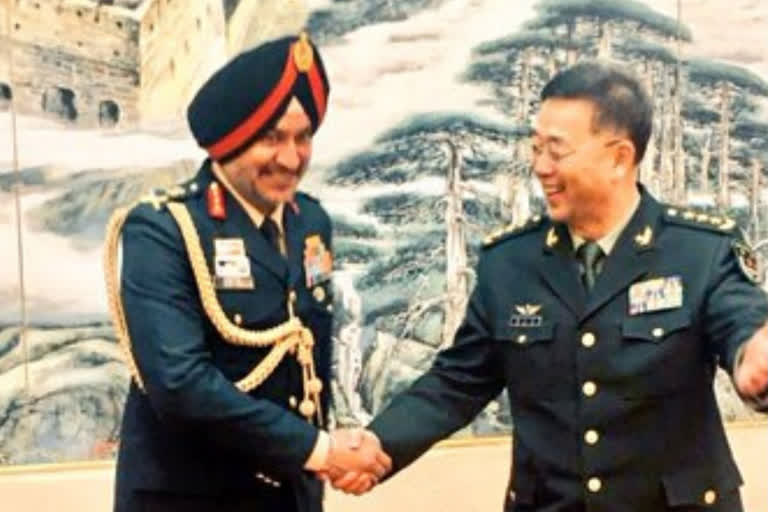New Delhi: A top Indian Army commander—Lieutenant General Ranbir Singh—is leading a strong military delegation on a five-day-long visit to China to see if border ‘misunderstandings’ can be avoided.
The Indian Army delegation met PLA General Han Wenguo on Wednesday and General Zhao Zongqi on Thursday. While Gen Han commands the 13 lakh strong main PLA formation called the Ground Forces, Gen Zhao is the commander of the Western Theatre Command which, along with the Ground Forces, is responsible for the front with India.
So both these generals are the ones directly dealing with India.
As one senior Indian Army officer dealing with the subject put it: “Meeting with them (the two PLA generals) will help understand the sensitivities on the ground and concerns of each other (India and China) which often result into misunderstandings on the border”. Later, Gen Singh’s team is also to visit military establishments and units in Urumqi and Shanghai.
Over time there has been a tacit acceptance by both India and China that tracing the Mcmohan Line—drawn on the basis of alignment with the mountain crest in the region in accordance with the watershed principle—dividing the two Asian giants on the Himalayas is easier said than done.
After all, old Mcmohan, a former British India foreign secretary (1911-1914), never did visit the icy heights on the Himalayas.
Despite Indian media hullaballoo now and then over patrolling Chinese soldiers found at the Indian side of the border (and similarly Indian soldiers also having been found at the wrong side of the border), it has, albeit gradually, dawned that much of what officially is termed ‘transgressions’ (as opposed to intrusion) is due to differing perceptions of the border.
At least that was the word used by former NSA Arvind Gupta during a meeting on Tuesday at the Vivekananda Foundation, a leading India think-tank institution.
On August 24 this year, present Indian Army chief Gen M M Naravane, then the vice-chief designate, had said: “If China transgressed at the LAC a 100 times, the Indian Army did so on 200 occasions”.
Just for an idea of the number of such transgressions, in 2014, speaking in the Rajya Sabha, then junior Union home minister Kiren Rijiju, put the figure at a total of 1,278 incidents between 2010-13.
Contrary to popular imagination, the meetings between Indian and Chinese soldiers often at the snow-covered border outposts are not all staid affairs often given to rage and fury but rather fun-filled many a time where—according to a military man who participated in such meets—a sought after commodity is the Old Monk rum, a famed Indian-made foreign liquor.
Much as they may be business-like, Gen Ranbir Singh’s meetings with People Liberation Army (PLA) counterparts during his ongoing China visit may not totally be devoid of bonhomie. Gen Singh, currently the Northern Command chief—this is the second-ever visit to China by a Northern Commander—is leading a delegation that includes a major-general and two colonels.
Significantly, the major-general is from the Eastern Command. So basically Gen Singh’s delegation represents the entire front with China—which is indicative of a deep intent to strengthen the existing border dispute resolution mechanism much of which comprises border outpost meetings.
The Northern Commands and the Eastern Commands are the ones facing the Chinese frontier, which is technically the LAC (Line of Actual Control), the defacto border between the two Asian giants.
China’s PLA has established mechanisms for exchanges with neighbouring countries at three levels: defence ministry levels, Theater Commands, and border troops. With a 22,000 km long land border, China has signed border cooperation agreements with nine neighbouring countries and set up border meeting mechanisms with 12 countries.
The Indo-China border is about 4,000 km long. Five states—Arunachal Pradesh (1,126 km), Uttarakhand (345 km), Jammu and Kashmir (1,597 km), Himachal Pradesh (260 km) and Sikkim (198 km)—share the international border with China.
The local commanders of the two armies meet regularly at five points along the border at Daulat Beg Oldie (Ladakh), Spanngur Gap (Ladakh), Bum-La (Arunachal Pradesh), Nathu-La (Sikkim) and Kibithu (Arunachal Pradesh).
Talking about the desired role of the armed forces vis a vis India, the 2019 China white paper “China’s National Defense in the New Era”, says: “They strive to promote stability and security along the border with India, and take effective measures to create favourable conditions for the peaceful resolution of the Donglang (Doklam) standoff”.
Interestingly, in an indication of the acceptance of the status quo, there is no mention of Arunachal Pradesh (which China claimed as its own) in the white paper. Perhaps that is the way things are going to be from now on.
With both India and China more than keen to resolve the geographical disagreement, it is a wonder how it has been allowed to fester for so long.
Also, read: Envoys from 16 nations in Kashmir to assess ground situation



